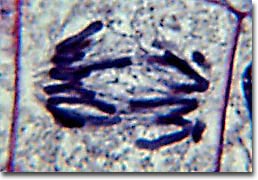There are 5 different stages of mitosis;
1.) interphase
2.) prophase
3.) metaphase
4.) anaphase
5.) telophase
While doing the onion tip activity, I found the following information:
| Interphase | Prophase | Metaphase | Anaphase | Telophase | Total |
| number of cells | 20 | 10 | 3 | 2 | 1 | 36 |
| percent of cells |  56% 56% | 28% | 8% | 6% | 3% | 100% |
|
Mitosis In Onion Root Tips
A mechanism is mitosis that allows the nuclei of cells to split and in return provide each of teh daughter cells with a full set of chromosomes during cellular division. This along with cytokinesis occur in all multicellular plants and animans to permit the growth of the organism, Cytokinesis is the division of cytoplasm.
Resting Cell
This normal resting cell is in a state called interphase, which the chromatin is undifferentiated in the heavily-stainded nucleus. (shown above). In order for a cell to enter the mitosis phase, it must first undergo a synthesis phase, which is where each chromosome is duplicated and consists of two sister chromatids that are joined together. Prophase is the first phase of mitosis. This is where the nuclear chromatin starts to become more organized and then condenses into a thick strand that will eventually become a chromosome.
Early Prophase
Late prohase, or what is known as prometaphase usually begins with the disruption of the nuclear envelope. This is broke down into small membrane vesicles that are very similar to the endoplasmic reticulum, and can tend to remain visible around the mitotic spindle. During this time, the chromosomes continue to condense and then gradually shorten and thicken until they are completely formed units that will soon undergo mitosis. The nucleolus will also disappear during this stage.
Late Prophase

Metaphase is where the chromosomes that are attached to the kinetochore microtubles begin to align with one plane known as the metaphase plate, which are located half way between the spindle poles. Due to the tension exerted by the kinetochore microtubules on the chromosomes and the entire spindle cromosome complex, we are now ready for the next event. The photo below shows a onion root tip cell chromosomes in metaphase, ready for seperation. You can clearly see the kinetochore and polar microtubules and they radiate out the ends of the cell, leaving the chromosomes in the middle.
Metaphase
Next around, the chromosomes are set up for seperation into the next stage called anaphase. Shortly after the metaphase chromosomes are alighned at the metaphase plate, two halves of each chromosome are pulled apart by the spindle apparatus and migrate to the opposite spindle poles. As the kinetochore microtubules are shortened, the chromosomes are pulled toward the poles with the polar microtubules elongate to assist in the seperation process.
Early Anaphase
Anaphase is known as a rapid process that lasts only a few short minutes. When chromosomes have completely migrated to the spindle poles, the kinetochore microtubules start to disappear while the polar microtubules continue to elongate. This is known as the junction between late anaphase and early telophase, which is the final step in chromosome division.
Late Anaphase
Telophase, the daughter chromosomes arrive at the spindle poles and are eventually redistributed into chromatin. Cytokinesis is the process in which the cytoplasm is divided by cleavage, and also starts sometime in late anaphase and continues through telophase. When the chromosomes and their extrusion to the spindle poles are completely separated, the nuclear membrane starts to reform around each group of chromosomes at the opposite ends of the cell. The nucleoli will also start to reappear in what will soon be the two new cell nuclei.
Telophase
After telophase is complete, the new cell membrane is now being formed. The nuclei have almost completely matured to the pre-mitotic state. The last steps include the completion of the total formation of a membrane between each of the new daughter cells to yield them to two separate new cells.
Daughter Cells









